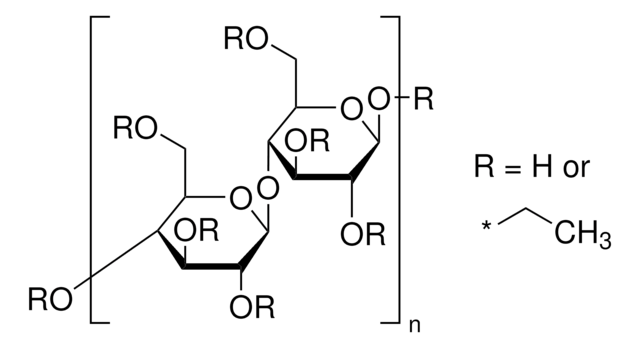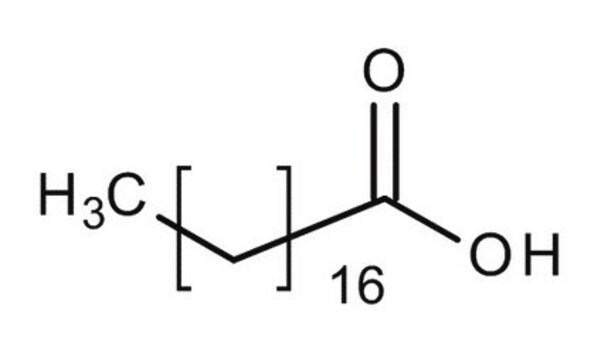200697
Ethyl cellulose
viscosity 22 cP, 5 % in toluene/ethanol 80:20(lit.), extent of labeling: 48% ethoxyl
Synonym(s):
Ethylcellulose
Sign Into View Organizational & Contract Pricing
All Photos(3)
About This Item
Recommended Products
form
powder
autoignition temp.
698 °F
concentration
47.5-49.5%
extent of labeling
48% ethoxyl
refractive index
n20/D 1.47 (lit.)
viscosity
22 cP, 5 % in toluene/ethanol 80:20(lit.)
transition temp
softening point 155 °C
density
1.14 g/mL at 25 °C (lit.)
Looking for similar products? Visit Product Comparison Guide
Related Categories
General description
Ethyl cellulose is a non-toxic polysaccharide type gelator widely used in surface coatings and biomedical applications.
Application
Ethyl cellulose can be used:
- To prepare oleogels for the ophthalmic delivery of hydrophilic drugs.
- As a coating agent to synthesize flexible bioplastics for packaging applications.
- To prepare CuO/Cu2O granules for thermochemical heat storage applications.
Storage Class Code
11 - Combustible Solids
WGK
WGK 1
Flash Point(F)
Not applicable
Flash Point(C)
Not applicable
Personal Protective Equipment
dust mask type N95 (US), Eyeshields, Gloves
Certificates of Analysis (COA)
Search for Certificates of Analysis (COA) by entering the products Lot/Batch Number. Lot and Batch Numbers can be found on a product’s label following the words ‘Lot’ or ‘Batch’.
Already Own This Product?
Find documentation for the products that you have recently purchased in the Document Library.
Customers Also Viewed
N Suwannateep et al.
European journal of pharmaceutics and biopharmaceutics : official journal of Arbeitsgemeinschaft fur Pharmazeutische Verfahrenstechnik e.V, 82(3), 485-490 (2012-09-08)
The phytochemical curcumin possesses antioxidant activity; however, it becomes unstable after being exposed to light or heat or loses activity during storage. This is especially important when curcumin is applied to the skin within a cosmetic or pharmaceutical formulation, since
Syed Umer Jan et al.
Pakistan journal of pharmaceutical sciences, 25(4), 751-756 (2012-09-27)
The aim and objective of the present study was to formulate and evaluate controlled release polymeric tablets of ibuprofen with determinations of formulation factors using various grades and types of polymer ethocel i.e. ethocel standard 10P; 10FP, 100P and100FP for
Anurag Verma et al.
Acta pharmaceutica (Zagreb, Croatia), 62(2), 237-250 (2012-07-04)
Chitosan has become a focus of major interest in recent years due to its excellent biocompatibility, biodegradability and non-toxicity. Although this material has already been extensively investigated in the design of different types of drug delivery systems, it is still
Daniela Traini et al.
International journal of pharmaceutics, 438(1-2), 150-159 (2012-09-12)
The potential of excipient coating to enhance aerosol performance of micronized drugs in carrier excipient-drug blends, used in dry powder inhalers, was investigated. Both EC (ethyl cellulose) and PVP (polyvinylpyrrolidone) were used as coating agents. Carriers were prepared via sieve
Ritesh M Pabari et al.
Expert opinion on drug delivery, 9(12), 1463-1474 (2012-10-16)
To examine the potential of a novel 3-fluid nozzle spray drying technology to formulate differentiated layered microparticles (MPs) of diclofenac sodium (DFS)/ethyl cellulose (EC). DFS/EC MPs were formulated using the inner and/or outer nozzles of a novel 3-fluid nozzle and
Our team of scientists has experience in all areas of research including Life Science, Material Science, Chemical Synthesis, Chromatography, Analytical and many others.
Contact Technical Service



